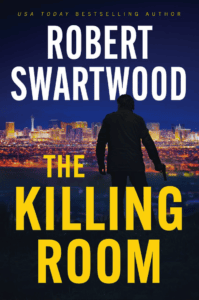Try to leave out the part that readers tend to skip.
Out of all of Elmore Leonard’s Rules on Writing, that’s probably the most notable—and for good reason.
There’s nothing worse than when you find yourself slogging through a book. The reasons can vary, but usually it’s because what’s on the page doesn’t need to be there. The writing is … what’s the opposite of tight?
Loose?
Lax?
You know what I mean.
A while back—what feels like many decades now but is really only fourteen years—I coined a literary term: hint fiction.
I defined hint fiction as a story of 25 words or fewer that suggests a larger, more complex story. The grandddaddy of hint fiction being, of course, the infamous—and perhaps apocryphal—Hemingway six-word story: “For Sale. Baby shoes. Never worn.”
I’d like to think it’s because of this I’ve always tried to keep my writing—both in novels and especially in short stories—as tight as possible, where every chapter and scene and even word matter.
A lot of writers will say that of course they make sure every word matters, but … let’s be honest: oftentimes writers can be long-winded. They’ve come up with an amazing idea or compelling character and they want to make sure everything about that amazingness gets put on the page.
The thing is, sometimes less is more.
Heck, almost always less is more.
Cut Time Wasters. Open Scenes When It Matters.
I often reference the iconic—and very, very long-running—show Law & Order as an example of tight storytelling.
Because they’ve only got about forty minutes to squeeze in a lot of story, you often don’t see the pair of detectives leaving one crime scene and traveling to a witness’s or suspect’s place of business to question them. You don’t see them getting out of their car or strolling up the steps to the door or even ringing the bell. You don’t see them thumbing their phones as they wait for someone to answer the door, and when the door is answered, you don’t see them introduce themselves and explain what they’re doing there.
No, the scene picks up with the witness or suspect ALREADY talking about the deceased or where they happened to see a suspect or whatever.
That’s right—the scene opens right in the middle of a conversation, and for good reason: we as the viewer already know what the questions are, as they’d been set up in the previous scene. Plus, oftentimes the suspect or witness frames their answer in a way that also makes it clear what the question was.
It’s just one example, but it’s an important one that writers should keep in mind when crafting their stories and novels.
Ask Yourself: If I Cut It, Does It Matter?
When writing a novel, always ask yourself: Is this chapter needed? If you were to take out the chapter entirely, would it affect the book in any way? Could you, perhaps, summarize what takes place in that chapter into a paragraph or two and still not lose any momentum or impact?
The same goes for characters. Obviously your protagonist is needed (or are they?), but what about secondary—and even tertiary—characters?
I once wrote a book in which a few chapters consisted of two minor characters, and my editor smartly pointed out that both weren’t needed and one could be absorbed into the other—their roles, while serving a purpose, did not require TWO people to serve that purpose, and so one character was axed and the other carried on without any problems.
Finally, once you’ve examined your novel and asked yourself if you could cut various chapters and characters, then start with scenes.
Again, think about Law & Order: we don’t have to see a guy getting off his plane at the airport and walking through the terminal and waiting for his checked luggage and then hailing a taxi and taking it to a hotel and waiting in line so he can check in at the front desk and then take the elevator up to his floor and fumble with his key before managing to unlock the door and then …
Yeah, that’s boring stuff, isn’t it?
That’s the kind of stuff you’re apt to skim over or even skip as a reader.
And that’s why you, as the writer, should leave it out.
P.S. If you’re really adventurous, once you’ve gone through your book and determined that every chapter and character and scene is needed, then start going chapter by chapter and scene by scene and ask yourself if you can start cutting back on the last paragraph. And then the next to last paragraph. And so on.
Even sentences: if your paragraph has four sentences, could you get the same point across with only three?
Eventually, the more you self-edit with this stuff in mind, the quicker you’ll get to a place where your brain is already conscious of self-editing during the writing process, and then—fingers crossed—you’ll have yourself a novel or story with a bunch of parts that readers won’t tend to skip.
 Robert Swartwood is the USA Today bestselling author of The Serial Killer’s Wife, The Calling, Man of Wax, and several other novels. His work has appeared in The Los Angeles Review, The Daily Beast, ChiZine, Space and Time, Postscripts, and PANK. He created the
Robert Swartwood is the USA Today bestselling author of The Serial Killer’s Wife, The Calling, Man of Wax, and several other novels. His work has appeared in The Los Angeles Review, The Daily Beast, ChiZine, Space and Time, Postscripts, and PANK. He created the  term “hint fiction” and is the editor of Hint Fiction: An Anthology of Stories in 25 Words or Fewer. He lives with his wife in Pennsylvania. His latest critically acclaimed release, THE KILLING ROOM is available now.
term “hint fiction” and is the editor of Hint Fiction: An Anthology of Stories in 25 Words or Fewer. He lives with his wife in Pennsylvania. His latest critically acclaimed release, THE KILLING ROOM is available now.





